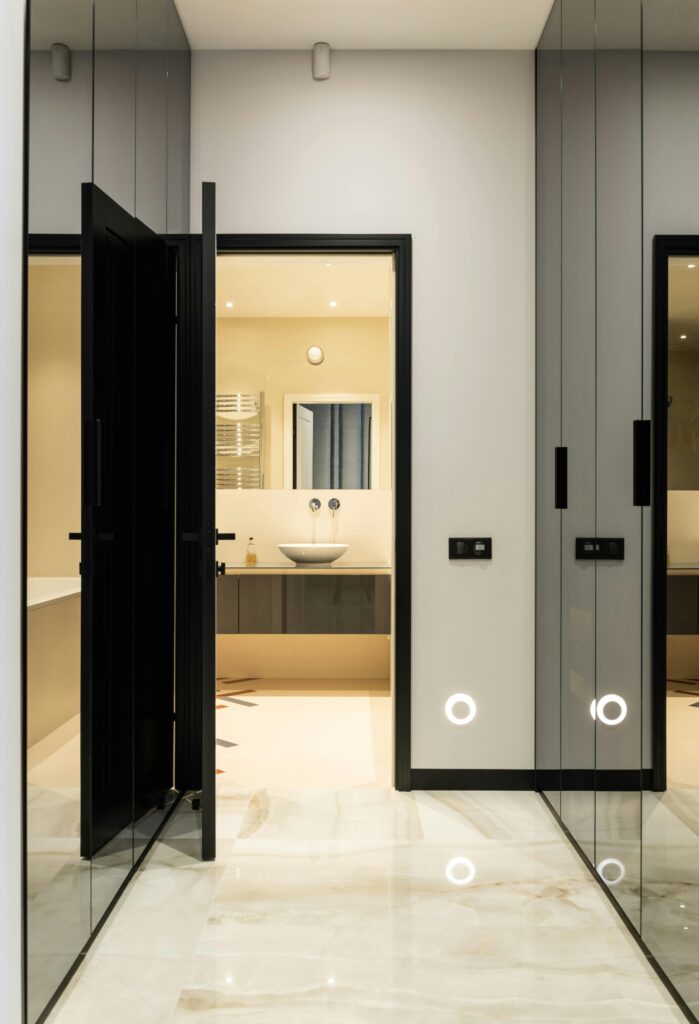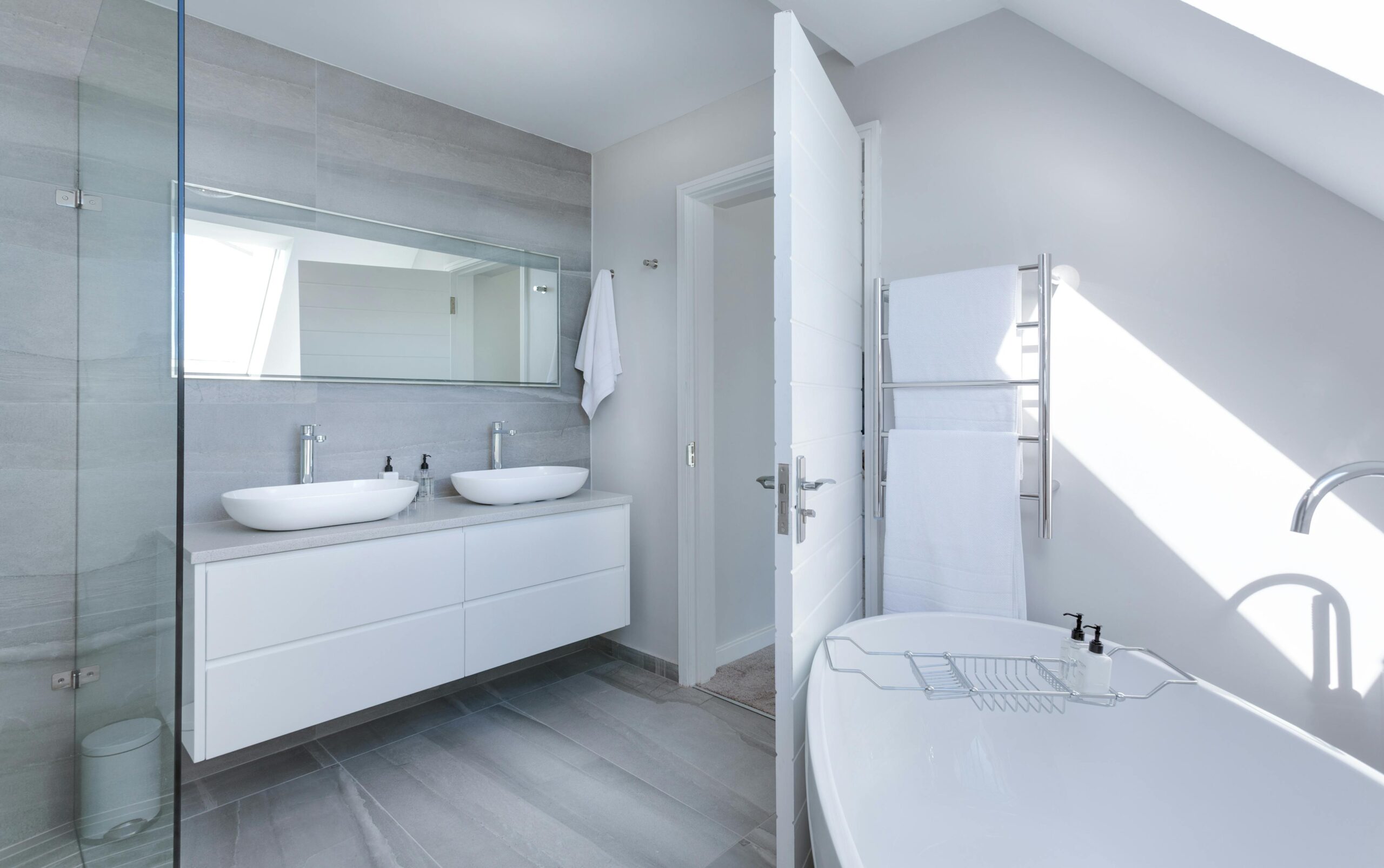Introduction to Bathroom Tiles
When it comes to designing or renovating a bathroom, one of the most important decisions you’ll make is choosing the right tiles. Bathroom tiles not only contribute to the aesthetic appeal of your space but also play a critical role in its functionality. With so many options out there, it can be overwhelming to decide what’s best for your bathroom.
In this guide, we’ll take a deep dive into the world of bathroom tiles, covering everything from ceramic tiles to mosaic patterns and luxury bathroom designs. Whether you’re remodeling or planning a new build, this guide will help you make informed decisions and turn your bathroom into a stylish, functional sanctuary.

Ceramic Tiles – The Versatile Choice
Ceramic tiles are one of the most popular options for bathroom floors and walls. They are made from natural clay and come in a variety of styles, colors, and finishes. The great thing about ceramic tiles is that they are durable, affordable, and easy to maintain, making them a go-to choice for many homeowners.
Ceramic tiles can be glazed or unglazed. Glazed ceramic tiles have a protective layer that makes them resistant to stains, water, and bacteria. This is a key feature for bathrooms, where moisture is a constant concern.

Porcelain Flooring – Durability Meets Style
If you’re looking for something more durable than ceramic tiles, porcelain flooring is the perfect choice. Made from denser clay, porcelain tiles are extremely tough and can withstand moisture and heavy foot traffic. They are available in a variety of designs, from simple. The highly intricate patterns, and they’re often used in high-end bathrooms due to their luxurious feel.
Porcelain tiles are perfect for both the floor and the walls of a bathroom. They come in different finishes, including polished, matte, and textured, giving you endless options to match your bathroom style. A great feature of porcelain flooring is that it’s incredibly easy to clean. which is perfect for bathroom. the environments prone to spills and water splashes.
Shower Wall Tiles – Functional and Attractive
The shower area in your bathroom is where you need tiles that are both functional and aesthetically pleasing. Shower wall tiles are typically made from ceramic or porcelain, both of which are waterproof and easy to maintain. When selecting tiles for your shower, it’s important to choose materials that can withstand the constant exposure to water.
While choosing tiles for your shower, don’t forget to consider the size, shape, and texture. Subway tiles, for instance, are very popular for shower walls due to their classic design and ease of installation. If you’re into modern trends, consider using large-format tiles, which can make your shower space feel even more luxurious.
Mosaic Patterns – Adding a Touch of Art Bathroom Tiles
If you want to create a statement in your bathroom, mosaic patterns are an excellent choice. These small, intricate tiles can be arranged. In a variety of patterns and designs. allowing you to express your personality and style. Mosaic tiles can be used as accents or as the primary design for your walls or floors.
Mosaic tiles come in various materials, including glass, ceramic, porcelain, and even stone. The beauty of mosaics lies in the endless possibilities of combining different colors and textures to create unique patterns. Whether you’re going for a vintage look or something more contemporary. Mosaic patterns can elevate the entire vibe of your bathroom.
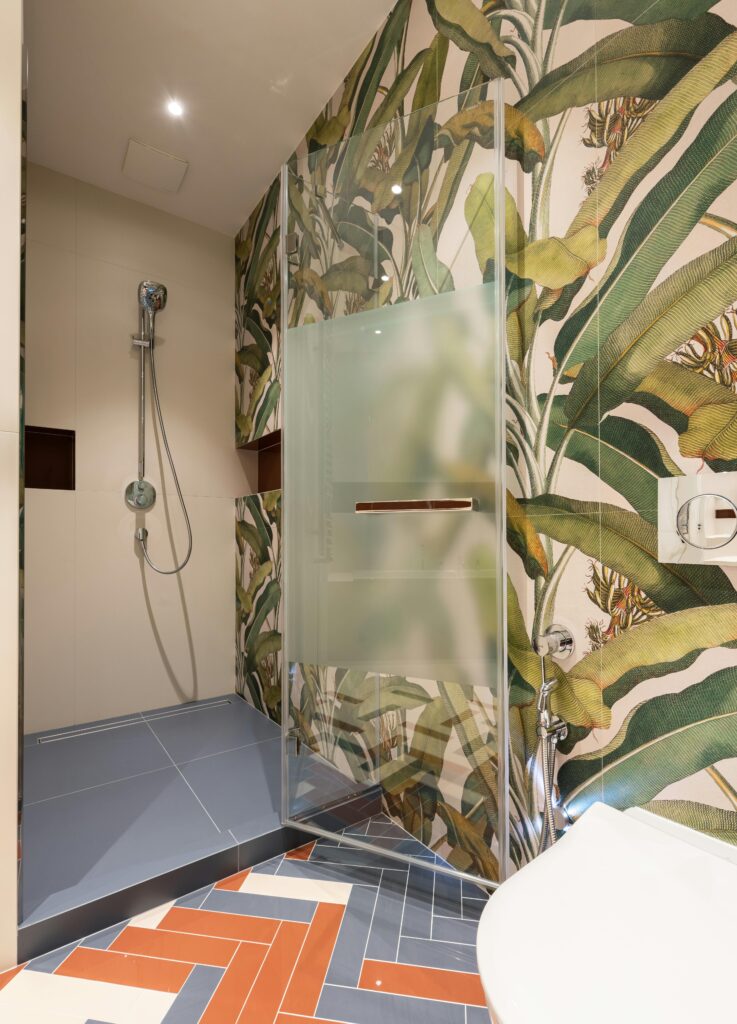
Waterproof Tiling – Essential for Bathrooms
In a bathroom, moisture is an unavoidable factor, which is why waterproof tiling is crucial. Choosing the right tiles that are waterproof or water-resistant ensures the longevity of your bathroom and helps in maintaining a hygienic environment. Ceramic and porcelain tiles, as mentioned earlier, are both water-resistant, making them excellent choices for any bathroom.
You can also opt for tiles with a waterproof sealant that prevents water from seeping through and damaging the underlying surface. When considering waterproof tiling, it’s essential to also think about grout maintenance, as the grout lines can sometimes absorb moisture if not properly sealed.
Slip-Resistant Flooring – Safety First
Bathrooms are high-traffic areas, and the last thing you want is for someone to slip and fall. Slip-resistant flooring is an absolute must, especially if you have children or elderly people in the household. Tiles with textured surfaces or a matte finish are excellent choices for preventing slips.
Porcelain and ceramic tiles with a slip-resistant finish provide added safety while still looking stylish. Many manufacturers now offer tiles specifically designed to provide better grip when wet, so you can enjoy a safe and attractive bathroom.
Subway Tiles – Timeless Elegance
If you’re looking for a timeless design, subway tiles are always in style. These classic rectangular tiles are widely used in bathroom designs, especially on walls. Subway tiles originated from the New York subway system and have since evolved into one of the most popular choices for bathroom interiors.
Subway tiles are often white, but they can come in a variety of colors, textures, and finishes. They are versatile and can be arranged in various ways, such as traditional brickwork, herringbone, or stacked patterns. Subway tiles offer a clean, neat, and modern look that works with virtually any bathroom design.
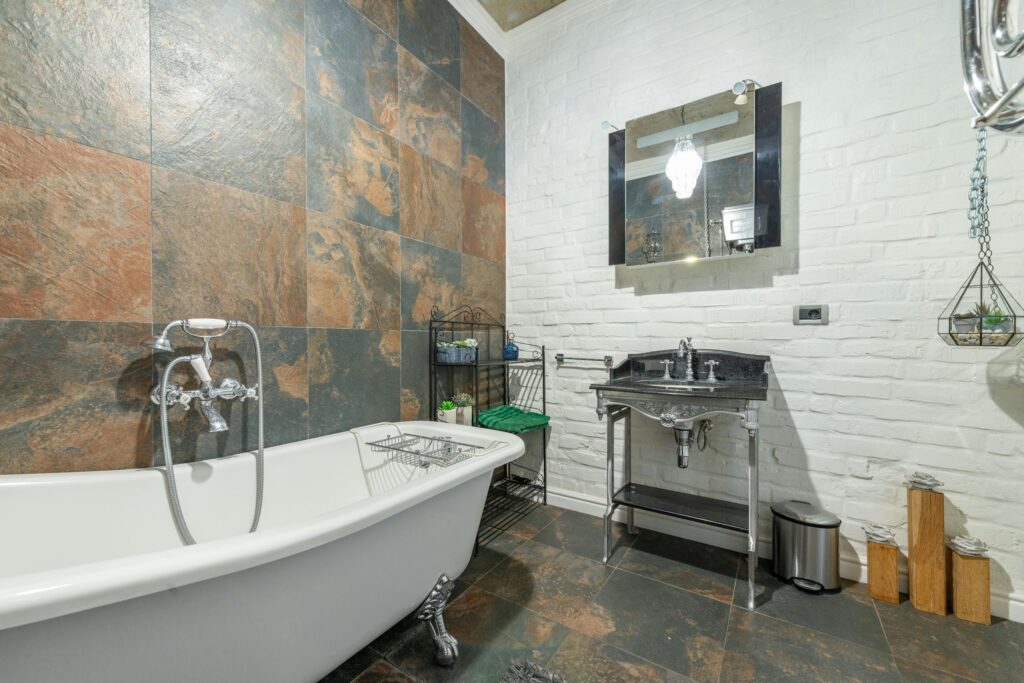
Marble Effect Tiles – Luxury Without the Price Tag Bathroom Tiles
If you love the look of marble but can’t quite afford the price tag, marble effect tiles are the perfect solution. These tiles mimic the look of real marble but are made from more affordable materials such as porcelain or ceramic. Marble effect tiles come in a variety of designs, from white with gray veining to more colorful and intricate marble patterns.
Using marble effect tiles in your bathroom can instantly elevate the space and give it a luxurious feel without breaking the bank. These tiles are just as durable and easy to maintain as traditional ceramic or porcelain tiles, making them ideal for any bathroom design.
Grout Maintenance – Keeping Your Tiles Clean and Safe
While tiles themselves are important, the grout between them plays a crucial role in the overall look and durability of your bathroom. Grout is a porous material, meaning it can absorb water, stains, and bacteria if not properly sealed and maintained.
To keep your grout in top condition, it’s important to clean it regularly and ensure that it is sealed to prevent moisture and mold buildup. There are many grout cleaners available on the market, or you can create a DIY cleaning solution using baking soda and vinegar.
Textured Surfaces – More Than Just Style Bathroom Tiles
Textured surfaces can add depth and character to your bathroom design. Whether you’re using them on the floor or the walls, textured tiles create an interesting visual appeal while also providing practical benefits. Textured tiles are particularly useful for areas prone to water exposure, such as shower walls or bathroom floors, as they are often more slip-resistant.
There are many different textures to choose from, including rough, matte, and raised patterns. The choice of texture can complement your overall bathroom design, whether you’re looking for a rustic vibe, a sleek modern look, or a touch of luxury.
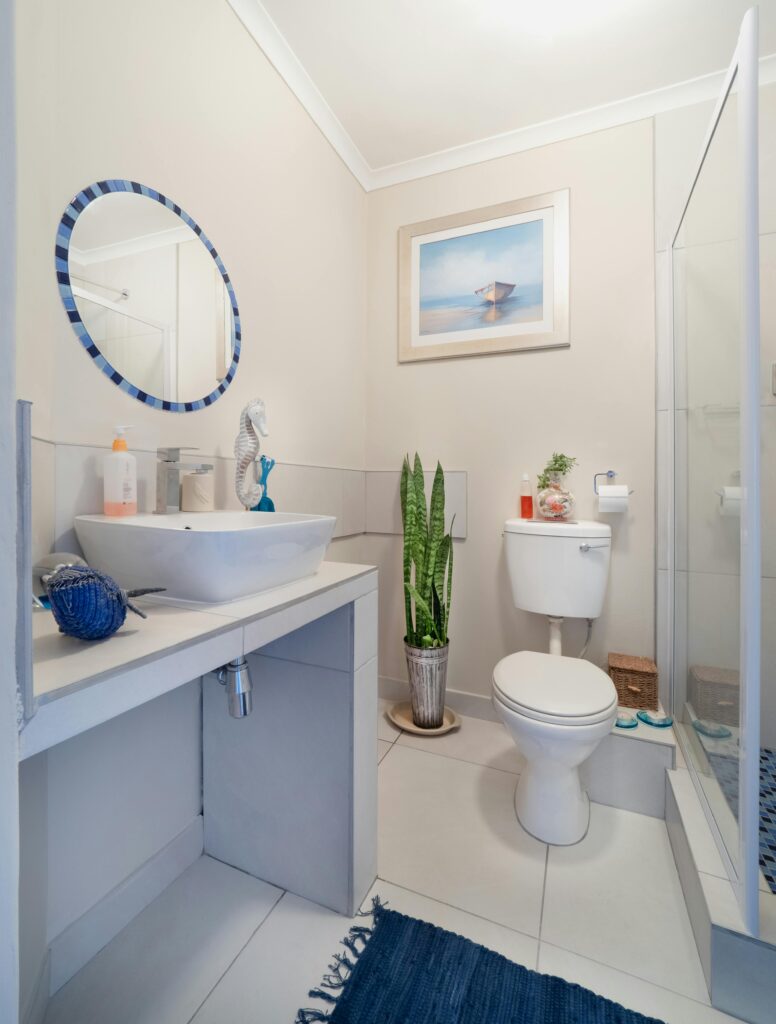
Tile Backsplash – Adding a Stylish Touch
A tile backsplash in the bathroom can do wonders for the overall aesthetic. Often used above bathroom vanities or sinks, a tile backsplash not only protects your walls from splashes but also provides an opportunity to introduce unique patterns or colors.
From simple subway tiles to intricate mosaic patterns, a tile backsplash can serve as the focal point of your bathroom or blend seamlessly with your other tile choices. It’s the perfect space to play with color and design, turning an otherwise functional feature into something visually stunning.
Luxury Bathroom Design – Creating a Spa-like Retreat
For those aiming for a luxury bathroom design, the tiles you choose will make all the difference. Marble effect tiles, porcelain flooring, and high-quality mosaic patterns can transform your bathroom into a personal spa retreat. A luxury bathroom doesn’t have to be large; even a small bathroom can feel opulent with the right tiles.
Consider using large-format tiles on both the floors and walls to make the space feel bigger. Combine materials like glass, stone, and polished porcelain to create a sophisticated look. Adding elements like underfloor heating beneath the tiles can elevate the luxury experience even further.
The Benefits of Large Format Tiles
Large-format tiles are becoming increasingly popular for both floors and walls in bathrooms. These tiles, typically larger than the standard 12” x 12” size, can make a small bathroom feel much bigger due to fewer grout lines. They also add a sense of sophistication and modernity to any bathroom design.
Large-format tiles are often used in luxury bathrooms for a clean, minimalist look. Whether it’s porcelain or ceramic, the key is choosing tiles that are both durable and aesthetically pleasing. Keep in mind, however, that the larger the tile, the more difficult installation can be, so hiring a professional may be necessary.

Eco-Friendly Tiles – Sustainability in the Bathroom Tiles
As the world becomes more eco-conscious, eco-friendly tiles are gaining popularity in bathroom design. These tiles are made from sustainable materials like recycled glass, bamboo, and even recycled ceramics. They offer the same durability and beauty as traditional tiles but with a much smaller environmental impact.
Eco-friendly tiles come in many forms, from beautiful glass mosaics to large-format porcelain tiles made from recycled materials. Not only will you be creating a stylish bathroom, but you’ll also be contributing to a more sustainable planet.
Understanding Tile Sizes – Finding the Right Fit
Tile sizes can greatly influence the overall appearance of your bathroom. Subway tiles are typically smaller, while large-format tiles offer a sleek, modern look. Choosing the right tile size depends on the size of your bathroom and the design aesthetic you’re going for.
For small bathrooms, large tiles can create an illusion of more space, while smaller tiles like mosaics can add texture and color. In a larger bathroom, you might want to mix and match different tile sizes to create an engaging design.
Tile Maintenance – Keeping Your Tiles in Top Shape
No matter how beautiful your bathroom tiles are, they need proper maintenance to stay looking great. Tile maintenance involves regular cleaning, sealing, and occasionally replacing grout to keep your tiles functioning properly.
Most tiles, whether ceramic, porcelain, or marble effect, are easy to clean. A gentle tile cleaner is usually all you need. However, some tiles, like mosaic patterns or textured surfaces, may require a bit more attention to detail when cleaning, as dirt can get trapped in the grooves.
Placeholder for Image 16: A person wiping down bathroom tiles with a cloth. Alt tag: “Person cleaning bathroom tiles with care.”
Choosing Grout Colors – Enhancing Your Tile Design
Choosing the right grout color can be as important as choosing the tile itself. A contrasting grout color can make each tile stand out, while a matching grout color will create a seamless, unified look. If you’re working with mosaic patterns, a contrasting grout will highlight the intricate designs and colors.
For a modern look, try a dark grout with white subway tiles or a light grout with dark porcelain tiles. For a more subtle effect, choose a grout color that closely matches the color of your tiles.
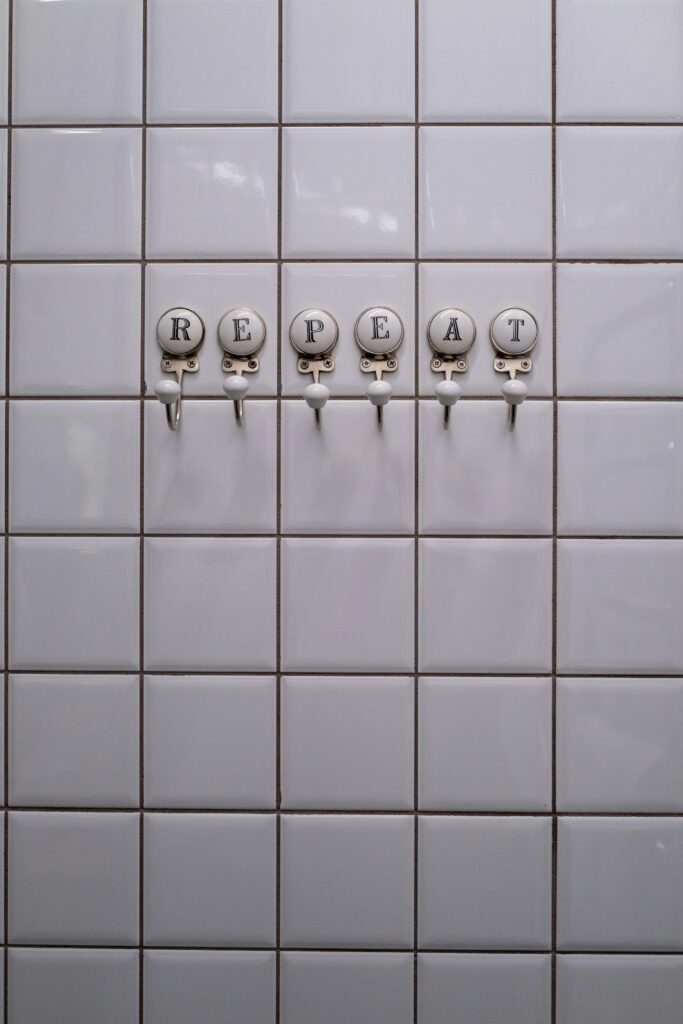
DIY vs. Professional Installation – What You Need to Know Bathroom Tiles
While DIY tile installation can save you money, it’s important to assess whether you have the skills to do the job properly. Ceramic tiles are relatively easy to install, but intricate designs like mosaic patterns or large-format tiles may require a professional to ensure the tiles are placed correctly.
A professional tile installer will ensure that the tiles are properly aligned, the grout is applied neatly, and the waterproofing is done effectively. For those who prefer a more hands-off approach or complex tile designs, hiring a professional is always a good idea.
Conclusion – Creating Your Dream Bathroom Tiles
Choosing the right tiles is essential in creating a bathroom that is both beautiful and functional. Whether you’re opting for luxury bathroom design with marble effect tiles or going for a classic look with subway tiles, the options are endless.
Remember to consider your personal style, the size of your bathroom, and the functionality of your tiles when making your decisions. With the right knowledge and a little creativity, you can design a bathroom that will be the envy of all your guests.
Final Word
We hope this guide has helped you understand the ins and outs of bathroom tiles. From porcelain flooring to slip-resistant options, there’s a tile out there that suits every need and style. Happy tiling!
Creating an Inviting Atmosphere with Color
One of the most important aspects of tile selection is color. The right color palette can make or break the vibe of your bathroom. Whether you’re after a serene and relaxing retreat or a bold, modern aesthetic, choosing the right tile color is crucial.
For a calming atmosphere, opt for soft blues, grays, and whites. These colors are known for their ability to create a tranquil environment. For a more vibrant and energetic space, consider bright accents or bold-colored mosaic patterns. Remember, lighter colors tend to make a space feel bigger, while darker shades can add warmth and intimacy.
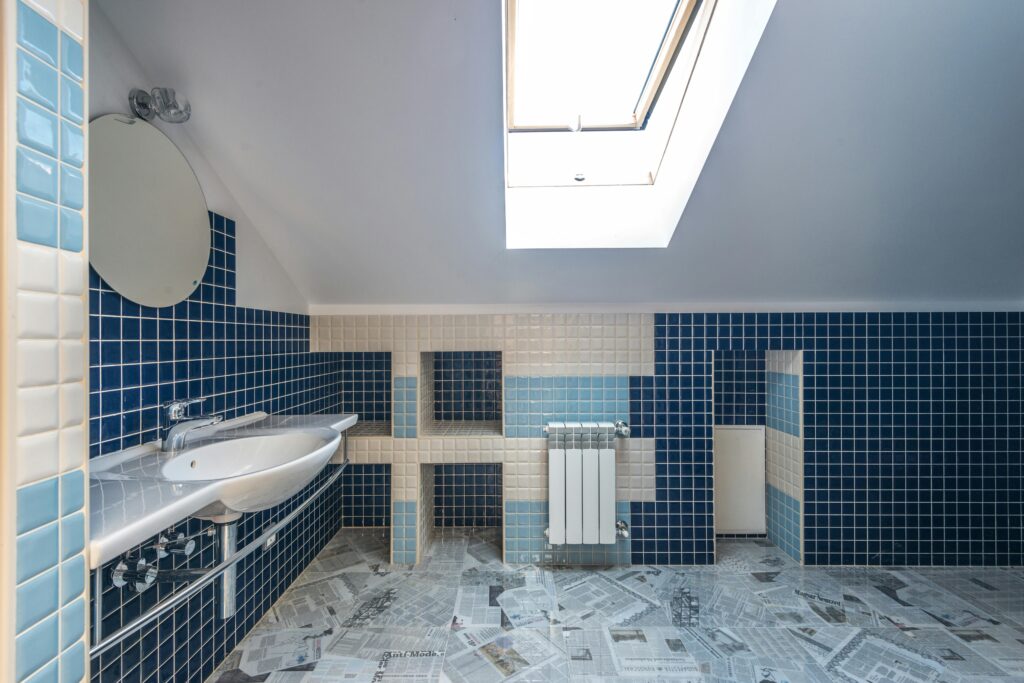
Mixing Tile Materials for a Unique Design
Why settle for just one type of tile when you can mix materials for a truly unique design? Combining porcelain, ceramic, marble effect tiles, and even mosaic patterns can create a visually appealing and dynamic look for your bathroom.
For example, consider using ceramic subway tiles for your shower walls and porcelain flooring for your bathroom floor. The contrast between the two materials can add an extra layer of depth and texture to your bathroom design. Just make sure the materials complement each other in terms of color, texture, and finish.
The Influence of Trends on Tile Design
Tile designs evolve with the times, and each year brings new trends to the forefront. From modern subway tiles to artistic mosaic patterns, staying on top of tile trends can help you create a bathroom that feels fresh and contemporary.
In recent years, marble effect tiles have gained popularity for their luxurious appearance without the hefty price tag. Another trend to watch is the use of large-format tiles to create a more minimalist, seamless look. Be sure to balance trends with your personal style to avoid designing a bathroom that feels too temporary.
Overcoming Common Tile Installation Issues Bathroom Tiles
Tile installation isn’t always smooth sailing. Whether you’re taking the DIY route or hiring a professional, it’s important to be prepared for some common challenges. Issues like uneven floors, misaligned tiles, or difficulty with grout application can pop up during the installation process.
To avoid these problems, ensure that your bathroom surfaces are clean, dry, and level before beginning installation. If you’re working with large porcelain tiles or intricate mosaic patterns, it’s crucial to plan ahead and take your time during installation. Rushing can lead to mistakes that might affect the overall look and function of your tiles.
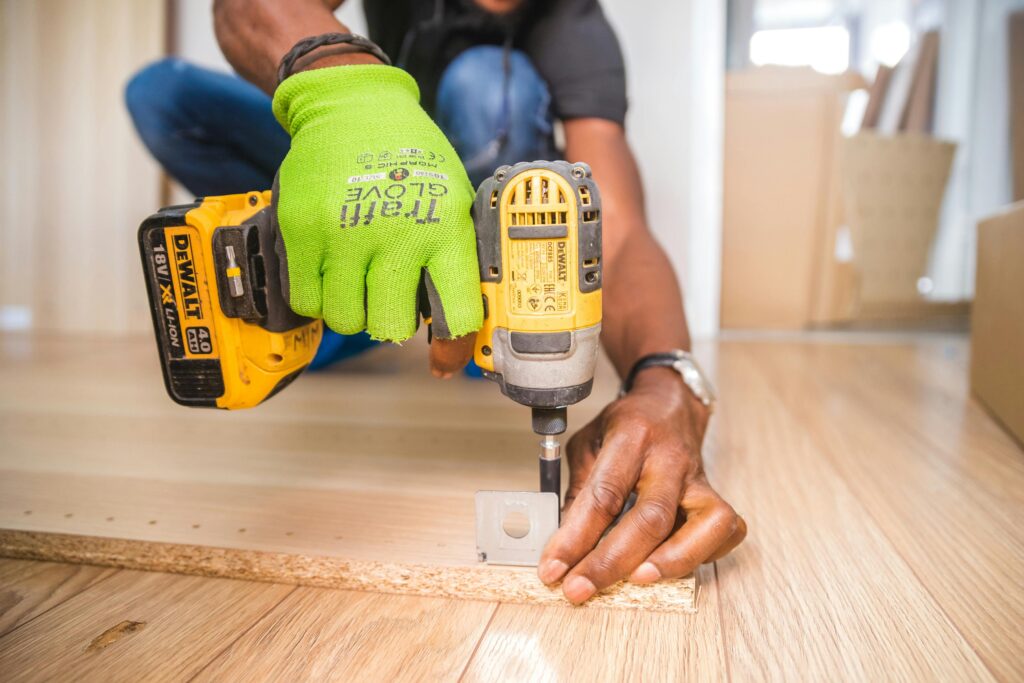
Enhancing Your Bathroom with Tile Borders
Tile borders are a great way to add a touch of sophistication to your bathroom design. These decorative tiles are often used to frame areas like mirrors, windows, or the edges of your shower. They come in a variety of styles, from simple borders to intricate mosaic patterns.
Consider using marble effect tiles for a sleek, high-end border or ceramic tiles with bold colors to add a pop of personality. Tile borders are a simple yet effective way to enhance your bathroom without overwhelming the design.
Choosing the Right Tile for Small Bathrooms
Small bathrooms present unique challenges when it comes to design. One of the easiest ways to make a small bathroom feel larger is by choosing large-format tiles for both the floors and walls. Large tiles with fewer grout lines help create a sense of openness.
Another tip for small bathrooms is to use light-colored tiles such as white, cream, or soft pastels. These colors reflect more light and can make the space feel brighter and more expansive. Also, consider using mosaic patterns for accents, like around your vanity or shower, to add some personality to the space without overwhelming it.
Waterproofing Tips for Bathroom Tiles
Bathrooms are one of the most moisture-heavy areas in the home, so it’s crucial to focus on waterproofing your tiles. While most porcelain and ceramic tiles are naturally water-resistant, the grout between the tiles can still absorb moisture over time, which can lead to mold and mildew growth.
To ensure your bathroom remains water-tight, make sure to use a waterproof grout sealant to protect the grout from moisture. Additionally, apply a waterproof membrane beneath your tiles to prevent water from seeping through the floor or walls. This will help protect your bathroom from water damage and keep your tiles looking pristine for years.
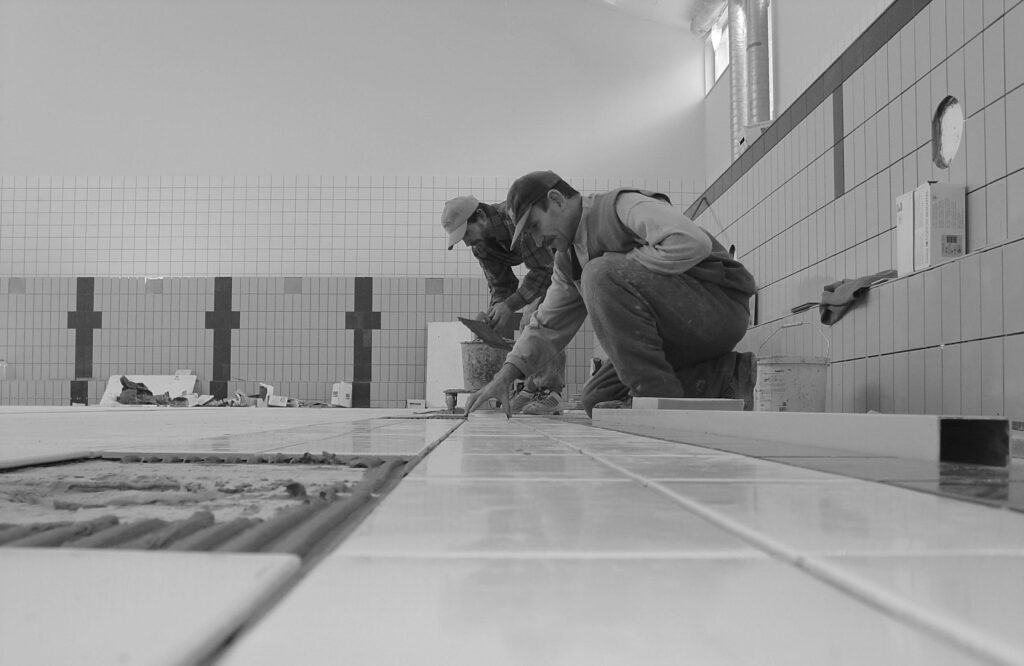
Customizing Your Tiles with Decorative Elements Bathroom Tiles
If you want your bathroom to truly reflect your style, consider customizing your tiles. Many tile manufacturers offer options for creating bespoke tiles, whether it’s through color, texture, or pattern. If you’re a fan of mosaic patterns, you can create a custom design using a variety of colored tiles to make a one-of-a-kind feature wall or backsplash.
Another fun way to customize your tiles is by incorporating decorative elements like tile borders, raised textures, or even personalized designs that speak to your aesthetic preferences. Whether you prefer a minimalist, rustic, or opulent design, customizing your tiles allows you to create a bathroom that is uniquely yours.
Tile Trends to Watch in the Future Bathroom Tiles
The world of bathroom tile design is always evolving, and it’s important to stay on top of trends if you’re planning a renovation or new build. In the future, we’re likely to see even more emphasis on eco-friendly materials, smart tiles with built-in technology, and creative uses of color and texture.
Expect to see more biophilic design elements incorporated into bathrooms, such as tiles that mimic natural stone or wood textures. Additionally, large-format tiles will continue to dominate the bathroom design world, especially as materials become more sustainable and versatile.
Final Thoughts – Your Bathroom, Your Tiles, Your Style
Choosing the right tiles for your bathroom is an exciting journey that allows you to express your personal style while creating a functional space. From ceramic tiles to luxury marble effect tiles, there’s an option for every taste and budget. By considering the factors of durability, aesthetics, and functionality, you’ll be able to transform your bathroom into a space that is both beautiful and practical.
Take your time to explore the various options available, consider the long-term maintenance, and choose a design that will stand the test of time. After all, your bathroom is a place where you begin and end each day – make it a space you truly love!
